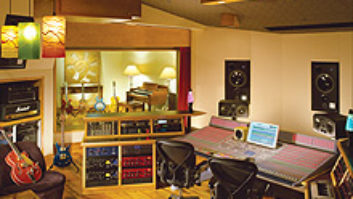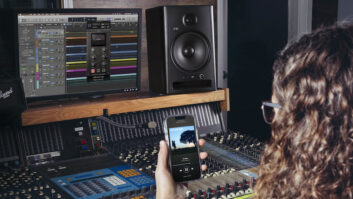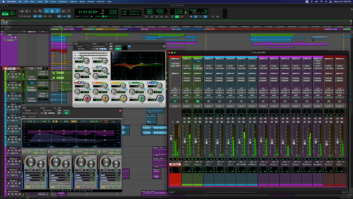SLS has produced sound reinforcement speakers for more than 25 years, but the Pro Studio S8R is its first foray into the studio monitor market. One look tells you that the S8R is not your ordinary woofer and tweeter in a box. The low-frequency driver has a torpedo-like conical phase plug in place of the usual dust cap, and high frequencies are handled by a planar-ribbon driver, rather than the typical dome tweeter. What’s more, the ribbon driver is positioned below the woofer.
The 8-inch, cast-frame woofer features a 2-inch voice coil. Its integral phase plug is said to eliminate resonance from air that would normally become trapped beneath a conventional dust cap. It also acts as a heat sink to improve power-handling capabilities and it lowers the mass of the cone for faster transient response and reduced distortion. But the proprietary PRD500 push-pull ribbon driver distinguishes the S8R from the competition. The 5-inch ribbon, which features a neodymium magnet structure, is set within a horn-like, flared metal casting. The “horn” provides 120°×40° (H×V) dispersion, and the entire driver can be rotated (by removing four screws) to ensure correct polar response when the S8Rs are mounted horizontally.
SLS, which pioneered the use of ribbon drivers in touring speakers, makes bold claims to its superiority over conventional dome tweeters. An exhaustive study is available on the company’s Website, but the basic argument is that ribbons offer a considerably faster transient response and much greater efficiency for a smoother sound over an extended frequency range. The frequency response is rated as 44 to 20k Hz (±2.5 dB), yet SLS claims a 6dB/octave roll-off that continues to 40 kHz. The 2.5kHz passive crossover has 12dB/octave HP and 6dB/octave LP slopes. Sensitivity is rated at 90 dB SPL (1 meter, 2.83 volts), with a max continuous SPL of 110 dB @ 1 meter. Power handling is 125 watts RMS, with 500W peaks.
The rear-ported reflex enclosure measures 19×10.5×11.25 inches (H×W×D) and weighs 25 pounds. The cabinet finish is NeverMar — the same durable black material used on SLS’ touring enclosures — and has no grille. (Oak veneer versions are also available.) The enclosure is designed for either vertical or horizontal use. Bracket screws for wall mounting are also provided. Input is via a pair of gold-plated, five-way binding posts that are tied together in parallel with external jumpers, allowing the drivers to be easily bi-wired or biamped without having to open the cabinet. Large through holes on each post accept wires up to 6 gauge (AWG).
I used the S8Rs powered by a Bryston 5B-ST amp in both tracking and mixing applications, as well as to audition a wide variety of audio material. SLS recommends that the ribbons be at ear level, which is why they are positioned below the woofers. At first, I found it nearly impossible to resist turning the S8Rs “upside down,” and after a week or so, that’s exactly what I did, yielding what were, for me, better results. I also tried positioning them horizontally but wound up switching them back to the vertical position with the ribbons on top.
Much more important than how the monitors are positioned is how the listener is positioned. There is a relatively narrow sweet spot where all of the elements come into balance, and even slight shifts from that spot result in major changes in sound. Apparently, this is simply a characteristic of ribbon drivers and is to be expected. If you work alone and sit in a more-or-less fixed position, then this shouldn’t pose a problem; but if you work with others, then you may find yourself playing musical chairs.
Overall, I very much like the sound of the S8Rs. The ribbon drivers deliver a very smooth and transparent sound, particularly in the frequency range above about 5 kHz. SLS cautions that it may take a while to adjust to the ribbon’s less-aggressive sound, as compared to dome tweeters, but I had no such problem. If anything, I found them to have more presence and sizzle around the 2.5kHz crossover point. Here, a simple 2dB cut at 2.5 kHz optimized them for my room. The bass response was quite adequate for an 8-inch woofer, though it could stand to be more tightly focused. Anyone mixing music with a lot of bottom will probably want to add a sub-woofer (SLS makes several models), as is common with many speakers this size.
With the speakers positioned vertically (ribbons on top) and a slight EQ adjustment, the results were uniformly outstanding. The imaging was concise with lots of subtle detail, and delicate sounds such as natural reverb decay (Paul Horn inside the Taj Mahal) were reproduced with great clarity.
The tricky upper-mid and high-frequency sounds of Indonesian gamelons and bells put the ribbons to the test, and they came through with flying colors. Acoustic jazz, bottom-heavy dub, modern rock and electronic music were all rendered accurately, and mixes done on the S8Rs translated well to other speaker systems. Bottom line: These are great speakers and should be seriously considered by anyone looking for monitors in this price range ($775/each).
SLS Loudspeakers, 3119 S. Scenic, Springfield, MO 65807; 417/883-4549; www.slsloudspeakers.com.
Barry Cleveland is a San Francisco-based engineer/producer/recording artist and author.




